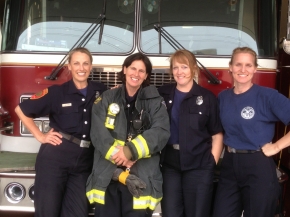Women's Exposures at Work

In 2012, the San Francisco Firefighters Cancer Prevention Foundation approached the United Fire Service Women and environmental health advocates with concerns about multiple cases of premenopausal breast cancer among their ranks.
Together, these groups discussed the need to understand breast cancer risk factors among women firefighters, particularly with regard to chemical exposures on the job. This evolved into a study, led by researchers at Silent Spring Institute and University of California, Berkeley to test the blood and urine of firefighters for exposures to chemicals linked to breast cancer, including carcinogens and chemicals that disrupt the body’s normal hormone function.
The Women Firefighters Biomonitoring Collaborative Study later expanded to include other types of jobs including office workers, nurses, and immigrant healthcare workers. The aim to is increase knowledge about women’s occupational exposures in general, an area that has been dramatically understudied, in order to create safer working environments for all.
Additional information:
News & Updates
2025
New study sheds light on chemical hazards in U.S. workplaces and overlooked risks for female workers.
2024
Study led by Silent Spring identifies 12 toxic chemicals that put female firefighters at increased risk for the disease.
2024
Silent Spring scientists made a dynamic impact at the 2024 International Society for Exposure Science (ISES) Annual Meeting in Montreal.
2023
A look at how community-based participatory research (CBPR) can be an effective tool for protecting women workers from hazardous chemical exposures on the job and creating healthier work environments.